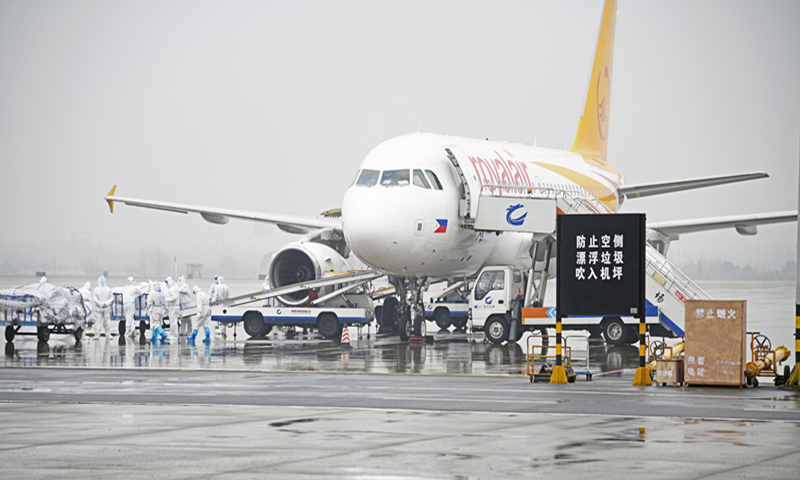Vaccine transport, cross-border e-commerce among driving forces
For a long time, air cargo has been the business area of large cross-border logistics companies including FedEx and some airlines based on key air cargo hub airports, and most airlines have taken cargo a supplement to the passenger transport business.
After the outbreak of the epidemic, passenger routes were suspended on a large scale, and the lack of belly cabin capacity of passenger aircraft, which accounted for half of air cargo capacity, made air cargo quickly got busy.
According to the data released by Civil Aviation Administration of China (CAAC), in 2020, when the belly compartment of a passenger aircraft carrying about 70 percent of the cargo volume is suspended, the cargo transport volume still reached 6.766 million tons, equivalent to 89.8 percent in 2019; airport cargo and mail throughput reached 16.079 million tons, a year-on-year decrease of only 6 percentage points.
As the impact of the epidemic begins to fade, will air cargo return to its previous “normal state”? Market insiders predicted that over the next few years, air cargo will continue to play a greater role than before the epidemic.
On May 11, Brian Pearce, chief economist from The International Air Transport Association (IATA) said in the past, freight revenue generally accounted for 10-15 percent of airlines’ total revenue, but now this figure has risen to 30-35 percent, according to Beijing-based China Times on Monday.
He predicted that due to the continued cross-border travel restrictions, many long routes will not return to normal in the next few years, so freight revenue will continue to account for a relatively high proportion of the airlines’ revenue structure.
One benefit of the epidemic is that airlines will recognize the contribution of freight business to overall revenue. With the entire industry in the dark, this has become a bright spot for airline business, Willie Walsh, IATA’s director general said.
One of the huge needs is vaccine transport, for there has never been a time in which billions of people in the world are facing the demand for vaccination, and the vaccine itself is the only large-scale global air transportation due to its special requirements. IATA estimates it requires at least the capacity of 8,000 747 freighters to meet this demand.
Another driving force is the cross-border e-commerce. According to the forecast issued by Deutsche Post’s DHL Express, by 2024, cross-border e-commerce in the Asia-Pacific region will reach $2.5 trillion. To this end, DHL added 8 Boeing 777F orders at the beginning of this year and will also add more capacity in the Asia-Pacific region.
According to data released by the logistics platform Cainiao, under Chinese e-commerce company Alibaba, it currently has more than 200 air cargo flights per month, and has established a supply chain network in 33 countries and regions. In 2020, Cainiao’s global parcel network handled more than 4 million cross-border parcels per day.
Customs data reveals that China’s cross-border e-commerce reached 419.5 billion yuan ($65.28 billion) in the first quarter, a year-on-year increase of 46.5 percent.
The busy freight market also brings more demand on cargo aircraft.
In early May, Boeing completed a passenger-to-cargo 737-800BCF freighter in Guangzhou and delivered it to China Postal Airlines. This is also one of the three 737-800 passenger-to-cargo production lines Boeing has opened in China. As a new generation of narrow-body aircraft passenger-to-cargo model, the 737-800BCF has accumulated more than 180 orders and commitments from 15 customers. Since the first delivery in 2018, Boeing has delivered more than 50 737-800BCF freighters.
According to Boeing’s forecast at the end of 2020, the world will need more than 2,400 freighters within the next 20 years to meet the air cargo market demand.
Cities’ ambitions
More cities in China are mapping the cargo business, and air cargo is becoming another hot spot for urban competition.
Local officials in Nanning Wuyu International Airport in South China’s Guangxi Zhuang Autonomous Region are also planning to promote cargo construction of the airport which aims to better serve ASEAN countries, according to industry outlet caacnews.com.cn on Monday.
Earlier this month, the west hub for SF Express, one of the logistics giants in China was settled in Chengdu, Southwest China’s Sichuan Province, which means that Chengdu will become the fourth regional international air cargo transshipment center of the company after Beijing, Hangzhou and Shenzhen.
Shenzhen also launched its transport map, aims to increase its cargo business in the airports to half after 3 to 5 years.
The goal of Xi’an Xianyang International Airport is to reach 15 percent of the cargo transfer rate by 2025, and strive to achieve an annual cargo throughput of 800,000 tons; Chongqing Jiangbei International Airport will achieve an annual cargo throughput of more than 800,000 tons by 2025.
The scale of cargo transportation increased by 9.0 percent compared with the same period in 2019, an increase of 5.3 percentage points from the previous month, data from CAAC showed.
A cargo flight lands in Changzhou, East China’s Jiangsu Province on March 15, 2021. Photo: VCG


